From research & with the help of wiki how. I was able to come up with some interesting procedure on how to capture a snake.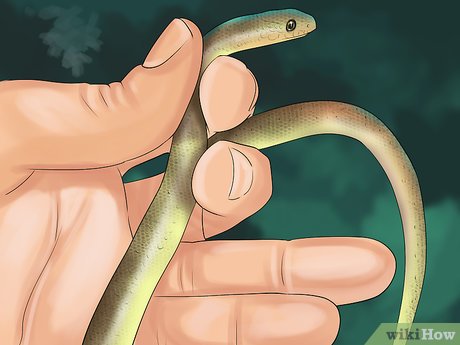 Picking Up a Snake by Hand is quit risky and dangerous, firstly ensure it's not venomous. You should never attempt to pick up a venomous snake under any circumstance. If, however, you're absolutely certain that a snake is not venomous, it may be safe to catch the snake by hand.
Picking Up a Snake by Hand is quit risky and dangerous, firstly ensure it's not venomous. You should never attempt to pick up a venomous snake under any circumstance. If, however, you're absolutely certain that a snake is not venomous, it may be safe to catch the snake by hand.
Never attempt to handle any snake you cannot identify with 100 percent certainty.
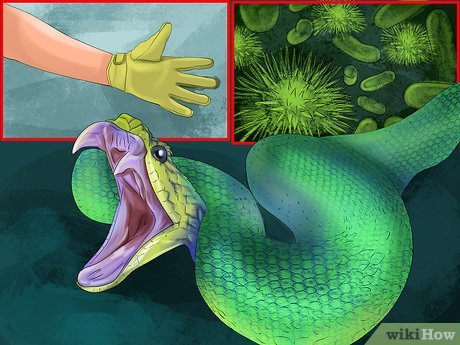
Wear thick gloves. If you're intent on picking up a snake that you've confirmed is not venomous, you should wear a thick pair of gloves. Just because the snake's bite will not kill you doesn't mean you should chance getting a painful bite.
Even a non-venomous snake's bite can be dangerous. All snakes have bacteria in their mouths which, if you are bitten, could penetrate the skin and lead to an infection.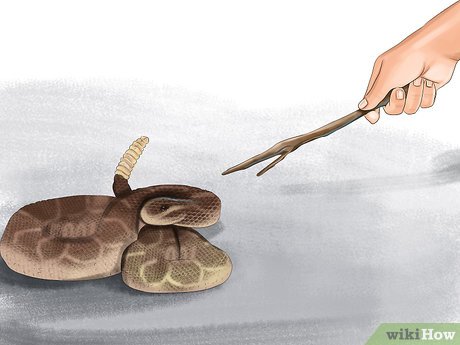
Distract the snake. As you approach the snake, you should distract it to ensure that it will not turn and strike you. Try to distract the snake away from your reaching hand with a long, sturdy object, like a long stick, a wooden yard stick, or a household fire poker.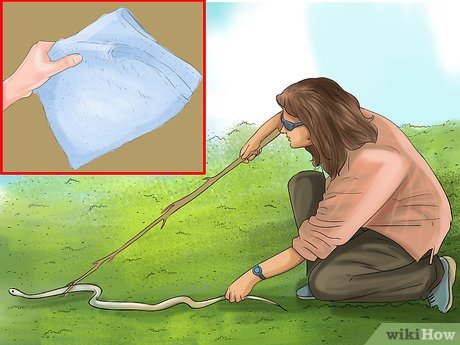
Keep the tool low to the ground and near the snake's head. This should distract the snake, as it will think the object is a potential threat.
Pick up the snake. Using your other hand (which, again, should be gloved), grab the snake's tail and lift it quickly. You should keep the majority of the snake's body flat on the ground until your grip is secure. Then you can use the long tool to lift the front part of the snake's body.
Alternately, you can drop an old shirt, towel, or thin blanket over the snake, scoop it up in the fabric, and gently drop the whole bundle into a pillowcase. You can then relocate the snake to a safe outdoor area away from people. This method is more dangerous, though, since you cannot see where the snake's head is, and it may bite you through the fabric.
If using a pillowcase, gently shake the pillowcase by the opening to ensure the snake is at the very bottom. If you must set the snake down, be sure you either twist the opening or flip it over on top of the rest of the pillowcase so that the snake cannot easily escape.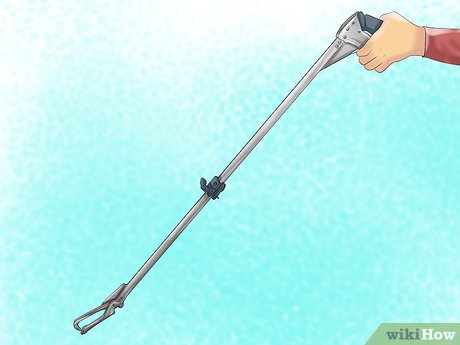
Using a Snake Hook or Tongs
Confirm it's not venomous. No matter how you intend to pick up a snake, you should always ensure that it is not venomous. A venomous snake can strike quickly, and if you're anything short of a professional you could fall victim to its dangerous bite.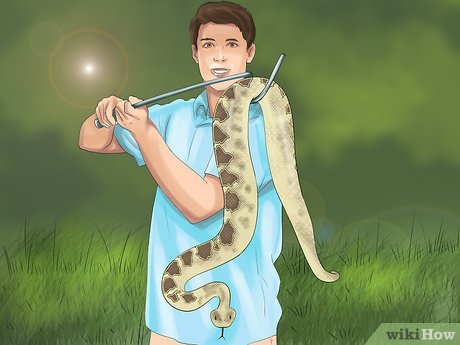
Have your tool on-hand. Whether you're using a snake hook or snake tongs, you should have the tool ready and on-hand before you approach the snake. You should also have a temporary container ready and close by so that you can gently place the snake inside once you catch it.
Some snakes are fast-moving and will not stay on a snake hook for more than a few seconds. If you cannot safely catch the snake and deposit it (gently) into the temporary container, you may want to consider using tongs, or leaving it to a professional.
If you feel comfortable using an intact pillowcase as a transport container, that should suffice. If the snake is outdoors, or is too large or aggressive for a pillow case, you may want to use something sturdier like an empty garbage can.
Be cautious if using snake tongs. These tools can be difficult for an inexperienced catcher to use, and could result in the snake being injured or even killed.
Lift the snake. If you're using a hook, carefully slip the hook underneath the snake's body. If using snake tongs, you should be able to simply grasp the snake using the tongs. No matter which tool you use, you should move quickly and carefully for both your own safety and the snake's.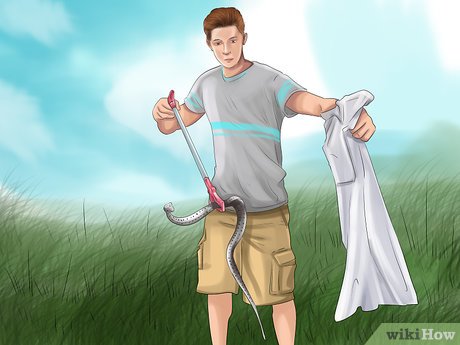
For smaller snakes, grab or lift the snake around the middle of its body or lower. For larger snakes, grab or lift the snake approximately 1/3 of the way down its body from the head.
You should never grab a snake by the neck, as this could cause serious injury and may make the snake struggle and bite you.
Move or contain the snake. If you're trying to move the snake a short distance, you may be able to simply carry it to the desired location. Otherwise, you should put the snake into a container to transport it or await for professional animal control personnel.
For smaller snakes, an intact pillowcase may suffice. Otherwise, use a deep bucket or, even better, a sturdy (and empty) garbage can.
Identifying North American Venomous.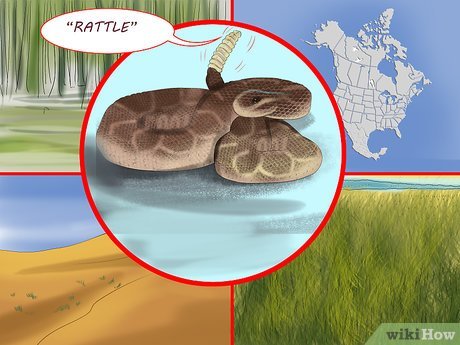
Recognize a rattlesnake. Rattlesnakes are fairly easy to recognize. Not all venomous snakes have a rattle, but rattlesnakes - one of the four most common venomous snakes in North America - do have this distinctive feature. A rattlesnake will typically warn you when you get too close by shaking its tail, producing the distinctive "rattle" sound.
There are over a dozen distinct species of rattlesnake across North America alone. Knowing which species inhabit which geographical regions in the country will help you narrow down which species you're dealing with.
Rattlesnakes also have a triangle-shaped head, which may make them fairly recognizable.
Depending on the species and its environment, fully-grown rattlesnakes can range from one foot in length to eight feet in length.
Rattlesnakes can live in forests, grasslands, swamps, deserts, and can also swim across bodies of water.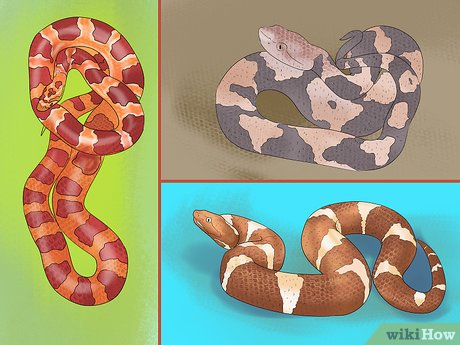
Identify a cottonmouth/water moccasin. The cottonmouth snake (also known as a water moccasin) is the only venomous water snake in North America. However, they are semi-aquatic, meaning cottonmouths can inhabit both aquatic and terrestrial habitats as needed. The most distinctive features of the cottonmouth are its head and mouth. The head is blocky and triangular, and the mouth (should you see it open) has white coloration on the inside. Many cottonmouths also have a distinct white, raccoon-like "mask," and an elliptical eye shape.
Cottonmouths can range in a number of colors, from copper/brown to black to green. Their coloration may be solid, spotty/blotchy, or in distinct bands.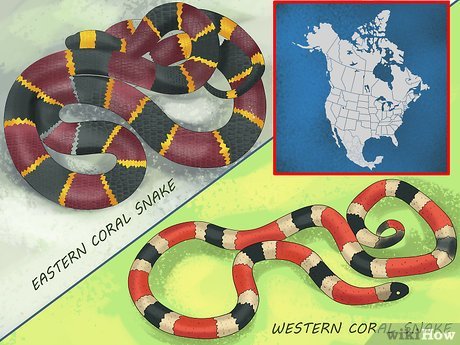
The native range of cottonmouth snakes is confined to the southeastern United States.
Spot a copperhead. Copperhead snakes have a similar appearance to cottonmouths, but their colors tend to be brighter. Many copperheads have a burnt copper to bright orange coloration, but some are silvery, pink, or even peach-colored.
Copperheads have a triangular head, whereas their look-alike the corn snake has a more oval-shaped head.
Recognize a coral snake. Coral snakes are from the cobra family. They typically have long, slender bodies, and their heads are marked by large scales. There are two species of coral snake commonly found in North America: the eastern coral snake and the western coral snake.
The western coral snake has a distinct banded color pattern: red on white on black, running the length of its body.
The eastern coral snake has a similar coloration, only its pattern is red on yellow on black.
Try to identify the type of snake you are dealing with before you attempt to handle it.
Always distract the snake. Even if it's non venomous, that doesn't mean that you will not be hurt by the snake's bite.
If you are unsure what kind of snake you're dealing with, or if you do not feel you can safely catch/handle the snake, call an expert - you can find the number for your local animal control agency in the phone book or online.
If you or someone you know is bitten by a snake, try to remember the color, shape, and size of the snake. If at all possible, take a photograph with a camera or cellphone. Try to remain calm, sit or lay down with the bite below heart level, and cover the bite with a clean, dry dressing. Then seek medical attention immediately, as time may be limited.
All snakes are capable of biting, as all snakes are carnivorous. A venomous snake's bite could be deadly. If you cannot properly identify a snake, or if you do not think you can safely handle one, avoid trying to do so at all costs.
If you pick up a snake, whether by hand or using a tool, it may panic. When it panics, it could thrash around and squirm, or it could turn quickly and try to strike you. Either way, you should always proceed with extreme caution.
Hi! I am a robot. I just upvoted you! I found similar content that readers might be interested in:
https://www.wikihow.com/Pick-up-a-Snake
Downvoting a post can decrease pending rewards and make it less visible. Common reasons:
Submit
Congratulations @ebukajaphet! You received a personal award!
Click here to view your Board
Do not miss the last post from @steemitboard:
Downvoting a post can decrease pending rewards and make it less visible. Common reasons:
Submit
Congratulations @ebukajaphet! You received a personal award!
You can view your badges on your Steem Board and compare to others on the Steem Ranking
Vote for @Steemitboard as a witness to get one more award and increased upvotes!
Downvoting a post can decrease pending rewards and make it less visible. Common reasons:
Submit